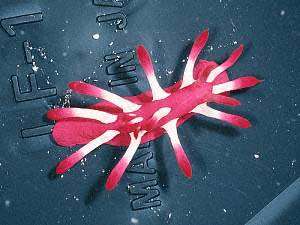
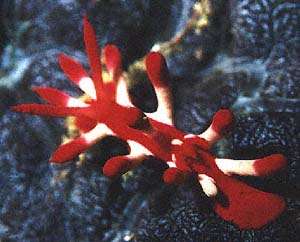
Okenia nakamotoensis
(Hamatani, 2001)
Order: NUDIBRANCHIA
Suborder: DORIDINA
Superfamily: ANADORIDOIDEA
Family: Goniodorididae
DISTRIBUTION
This species is known from the Kuroshima Island (Japan), Indonesia, Bohol and Cebu Islands (Philippines), and Enewetak and Kwajalein Atolls (Marshall Islands) (see Gosliner 2004). Also reported in the Forum from western Indian Ocean [message #11504 ].
PHOTO
Upper: SE Sulawesi, September, 1997. Photo: Bernard Picton. Lower: Philippines. Size: about 3 cm, Depth: about 20 m, Feb. 1997. Photo: Georg Heinze
NOTE:This animal was previously known on the Forum as Hopkinsia nakamotoensis.
It is a deep (carmine) red with rhinophores and gills of the same colour. The outer surfaces of the stalks of the gills are opaque and white and all dorsal appendages are whitish though the distal third is coloured with a deep red. The pallial margin is absent. The head is broad and forms a shield-like projection in front of the rhinophores. Five pairs of appendages are symmetrically arranged along the dorsal margin, a single appendage being present in the midline in front of the branchial gills. No oral tentacles have been observed. It has three small, simply pinnate, non-retractile gills. It grows to approximately 20mm long alive.
The radula is of a peculiar form for the Goniodorididae. The inner lateral teeth are extremely thin and elongate and have a hooked tip. They lack denticles. The outer laterals are small and reduced with an anteriorly directed cusp. See separate message [message #12637 ] for photo of radula.
In coloration this species closely resembles O. rosacea MacFarland, 1905, and O. hiroi Baba,1938, but this species has a lower number of dorsal appendages. The radular teeth are similar to those of H. rosacea but are more slender. It is also very similar in colour to O. kondoi but has a much broader body and bulbous dorsal appendages. The radula is also quite different. Gosliner (2004) places this species, and related species of Hopkinsia, in the genus Okenia. It is very similar on colour to O. kondoi which shares the same geographic range and the same bryozoan prey, Tropidozoum cellariforme Harmer, 1957, but differs in having a more slender shape and in radular morphology. It also differs from that species in having 5 pairs of dorso-lateral processes rather then 4. A similar species pair from northern Australia, O. stellata and O. hallucigenia have recently been described (Rudman, 2004).
-
Hamatani, I. (2001) Two new species of Goniodorididae (Opisthobranchia; Nudibranchia) with a new genus from Kuroshima Island, Okinawa, Japan. Venus, 60(3): 151-156.
-
Gosliner, T. M. (2004) Phylogenetic Systematics of Okenia, Sakishimaia, Hopkinsiella and Hopkinsia (Nudibranchia: Goniodorididae) with descriptions of new species from the tropical Indo-Pacific. Proceedings of the California Academy of Sciences, 55: 125-161.
-
Rudman, W.B. (2004) Further species of the opisthobranch genus Okenia (Nudibranchia: Goniodorididae) from the Indo-West Pacific. Zootaxa, 695: 1-70.
ARCHIVE NOTE: An earlier edition of this Fact Sheet [14 February 2002] as Hopkinsia nakamotoensis is available on request
Authorship detailsRudman, W.B., 2004 (December 21) Okenia nakamotoensis (Hamatani, 2001). [In] Sea Slug Forum. Australian Museum, Sydney. Available from http://www.seaslugforum.net/find/hopknaka
Related messages
Okenia nakamotoensis from Mabul Island, Malaysia
August 1, 2007
From: Paul Osmond
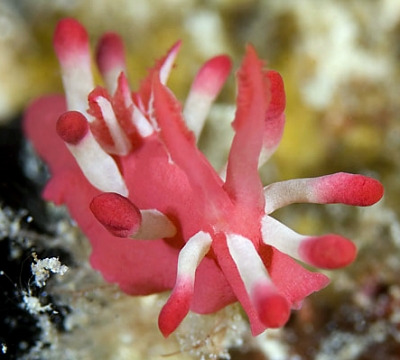
Hi Bill,
Found this rather striking nudibranch on one of the shallow reefs that surround Mabul Island in Sabah, Malaysia. Is it Okenia nakamotoensis?
Locality: Mabul Island, 10m, Sabah, Borneo, Malaysia, 13 March 2007, Shallow coral heads, sand ocean floor. Length: 25mm. Photographer: Paul T. Osmond.
Yours,
Paul
marriard@deepseaimages.com
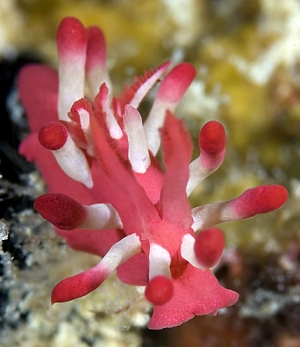
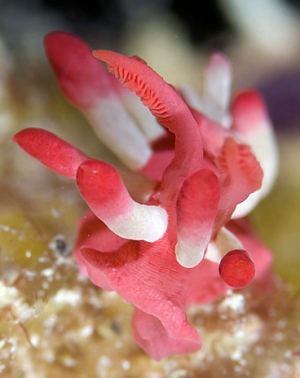
Dear Paul,
Yes this is Okenia nakamotoensis and it is the second record from Mabul. New records on the Forum are suggesting quite a wide range for this species, perhaps even across to the western Indian Ocean.
Best wishes,
Bill Rudman
Okenia nakamotoensis from Sabah, Malaysia
December 1, 2005
From: Dave Morgan
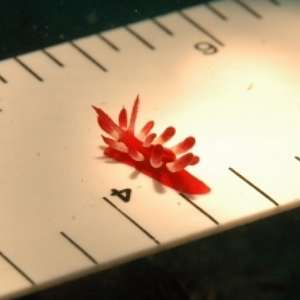
Dear Sir,
could you name this Nudibranch for me please, i took the photo in June 05 and can't find it in any book i have,
Locality: Mabul, Sabah, Malaysia, Celebes Sea. Depth: 17 metres. Length: 12 -15 mm. June 2005. Sandy / Coral bottom, Photographer: Dave Morgan
Thanks,
Dave Morgan
DAVE@SEATREKER.COM
Morgan, D., 2005 (Dec 1) Okenia nakamotoensis from Sabah, Malaysia. [Message in] Sea Slug Forum. Australian Museum, Sydney. Available from http://www.seaslugforum.net/find/15389Dear Morg..,
This is Okenia nakamotoensis. We are still learning about this recently described species so its nice to fill in another gap in its known distribution.
Best wishes,
Bill Rudman
Okenia nakamotoensis from the Indian Ocean
December 22, 2004
From: Marina Poddubetskaia
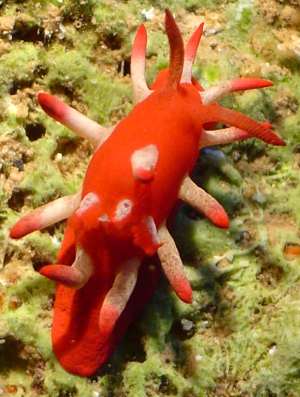
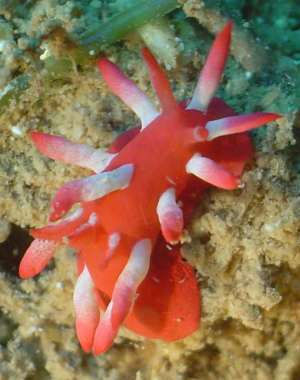
Dear Bill,
Probably, this is the most common species in Mayotte. I saw this species in many diving sites and in really huge numbers. It is probably due to the abundance of its food, the bryozoan Tropidozoum cellariiforme (see my second message - message #11505 ).
The identification of this species could be seen in the book Coral Reef Animals of the Indo-Pacific by Gosliner, Behrens, Williams. This book gives the identification of Okenia sp. food too.
I have asked Shireen Fahey if this species could be Hopkinsia nakamotoensis, very similar externally. Shireen told me that this one is a distinct species and it could be distinguished externally from H. nakamotoensis according to its foot which is smaller than the wider foot of Hopkinsia.
Location : M'Sapere, Mayotte Island, France, Indian Ocean
Site : Bouzi. Date: November 05, 2003
Photo 1: Depth : 8 m. Size : 10 mm
Photo 2: Depth : 7 m. Size : 8-10 mm
Photos: Marina Poddubetskaia
Best wishes,
Marina.
nembro@nembro.info
Poddubetskaia, M., 2004 (Dec 22) Okenia nakamotoensis from the Indian Ocean. [Message in] Sea Slug Forum. Australian Museum, Sydney. Available from http://www.seaslugforum.net/find/11504Dear Marina,
Thanks for this interesting contribution. Although we would need to have a look at its anatomy to be 100% certain, I am pretty sure this is indeed Okenia nakamotoensis . It agrees in colour pattern, number of mantle papillae, and food bryozoan [if your identification of the food is correct]. I think Shireen's concern about the width of the foot is unnecessary, as in this species the foot seems quite narrow when its on its food, but in fact that is beacuse it is wrapped around the narrow bryoan 'stalk'. When it is crawling on a flat surface the foot appears much wider. In your 2 photos the upper animal appears to have a much narrower foot them the lower one. Of the two species which feed on this bryozoan, Okenia kondoi is the one with the narrow foot. If my identification is correct, this is an interesting extension of the range of this species from Indonesia and the central west Pacific across to the western Indian Ocean.
I should have added this record to my recent paper on this genus, but I am afraid the only way I had time to do research was to ignore the growing stack of messages on the Forum which unfortunately meant that 3 or 4 on Okenia were missed by me.
Best wishes,
Bill Rudman
Okenia nakamotoensis - feeding observations
December 22, 2004
From: Marina Poddubetskaia
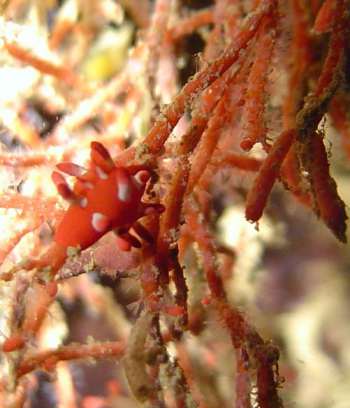
Dear Bill,
To complete my previous message [message #11504], here are the photos of Okenia nakamotoensis feeding on its bryozoan. In upper right nd lower left photos the bryozoan is clearly Tropidozoum cellariiforme, as identified in the book I mentioned [Gosliner, Behrens, & Williams]. As for the lower right photo, the bryozoan seems very different in colour and I'm not sure if it is the same species.
Upper Right: November 05, 2003
Location : M'Sapere, Mayotte Island, France, Indian Ocean
Site : Bouzi, Depth : 7 m, Size : 8-10 mm
Lower left: November 07, 2003
Location : Handrema, Mayotte Island, France, Indian Ocean
Site : Prevoyante, Depth : 15 m, Size : 8 mm
Lower right: November 12, 2003
Location : Kongou, Mayotte Island, France, Indian Ocean
Site : Recif de Peitro, Depth : 11 m, Size : 10 mm
-
Gosliner, T.M., Behrens, D. & Williams, G. (1996) Coral Reef Animals of the Indo-Pacific. Sea Challengers, Monterey, California, 314 pp, 1103 pls.
Cheers,
Marina.
nembro@nembro.info
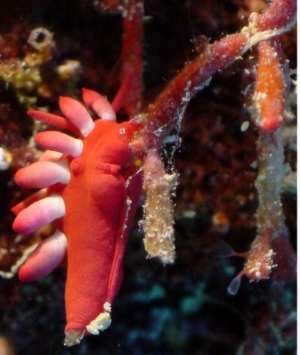
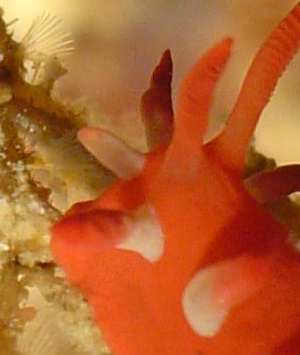
Dear Marina,
Thanks for these photos. It certainly looks like Tropidozoum cellariiforme, but I suspect bryozoan experts would need to look at a specimen before they would confirm the identification I think the lack of red in the lower right photo is either a sign the branch is dying or covered with something else. You'll see patches without red in the other photos as well. I just included a close-up of your third photo because is shows the bryozoan zoooids [upper left corner] very well.
Best wishes,
Bill Rudman
Radula of Okenia nakamotoensis
December 21, 2004
From: Bill Rudman
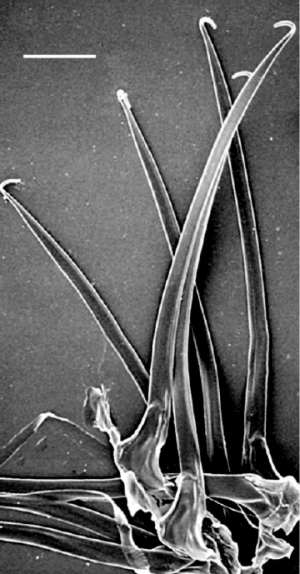
In Gosliner's recent review of Okenia, Hopkinsia nakamotoensis Hamatani, 2001 was one of the species which he considered was more appropriately placed in Okenia. One major difference from most members of that genus is the shape of the radular teeth which I have posted here thanks to the permission of Terry Gosliner.
The radular formula of this animal is 16 x 1.1.0.1.1. The inner lateral teeth are extremely thin and elongate and have recurved hook-like tip. They also lack denticles. The outer laterals are small and reduced with a forward pointed cusp.
PHOTO: Scanning electron micrograph showing long slender inner lateral
teeth, scale = 150 µm. (CASIZ 096238). Photo: T.M.Gosliner.
Gosliner, T. M. (2004) Phylogenetic Systematics of Okenia, Sakishimaia, Hopkinsiella and Hopkinsia (Nudibranchia: Goniodorididae) with descriptions of new species from the tropical Indo-Pacific. Proceedings of the California Academy of Sciences, 55: 125-161.
Bill Rudman
Rudman, W.B., 2004 (Dec 21) Radula of Okenia nakamotoensis. [Message in] Sea Slug Forum. Australian Museum, Sydney. Available from http://www.seaslugforum.net/find/12637Hopkinsia - final photos from Kwajalein
April 9, 2002
From: Scott Johnson
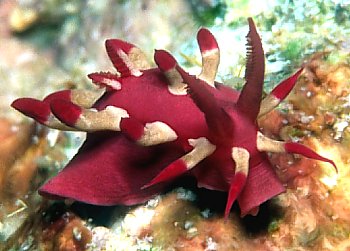
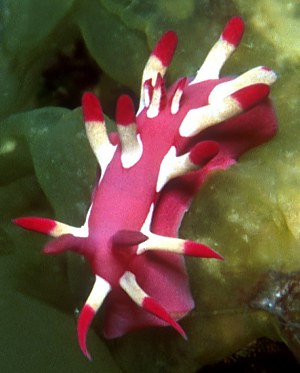
Dear Bill,
Here are two more photos of the Marshall Ids Hopkinsia [e170] taken by my wife, Jeanette.
They are from Kwajalein. Photos: Jeanette Johnson.
Scott.
johnson@kmr.ll.mit.edu
Johnson, S., 2002 (Apr 9) Hopkinsia - final photos from Kwajalein. [Message in] Sea Slug Forum. Australian Museum, Sydney. Available from http://www.seaslugforum.net/find/6423Thanks Scott & Jeanette,
This must surely be Hopkinsia nakomotoensis. From these photos the foot appears to be very broad in this species.
Best wishes,
Bill Rudman
Hopkinsia from Enewatak Atoll
April 8, 2002
From: Scott Johnson
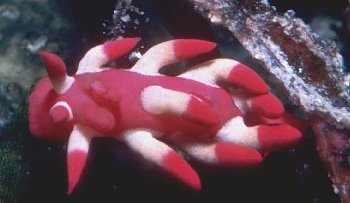
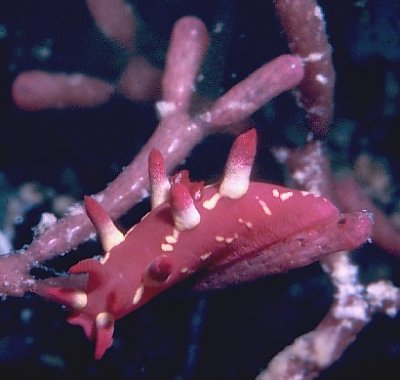
Hi Bill,
Concerning your comments on my earlier photos of 'Hopkinsia' from the Marshall Ids, I haven't come to any definite conclusions on whether I have one or two species. Looking back through my records, most of my specimens came from Kwajalein Atoll. On one occasion in 1983, I found 3 specimens on a single bryozoan at Enewetak atoll. At the time, I figured they were all the same and I'm still inclined to believe that.
I've sent most of the pictures I have in several different messages. I have renamed them so that the Enewetak and Kwajalein specimens are separate. Attached to this message are two shots taken at Enewetak to join the earlier one I sent which you suggested might be Sakishimaia kondoi. The lower photo in this message is obviously the same individual as in that earlier photo. These were all small. My notes on the Enewetak specimens say that two measured 7mm and one was 3mm in length. I suspect, although I cannot be sure, that the apparent narrowness of the animal in the earlier photo has to do with the fact that it's foot in the front appears to be folded back on itself. Notice how the foot is used to wrap around the bryozoan in a photo from Kwajalein I am sending in a separate message.
As for the bryozoan, while I again cannot be certain, I believe they are the same in both places. The one at Kwajalein looks "fuzzier" but I think that is growth and debris on the bryozoan. The Enewetak specimens were found at a place called the Cement Ship Pinnacle, a pinnacle reef set just in the lagoon from the atoll's single deep-water pass. We could dive there only at slack tide due to the raging currents that swept over the reef. This may have kept the bryozoan "cleaner." At Kwajalein, on the other hand, all the animals have been found on two or three lagoon pinnacles in much quieter water, well out into the lagoon and far from any passes. Further, these are more or less downwind of an island named Ebeye, where 14000 Marshallese live on an island that is maybe as much as a couple of km long and a few hundred meters wide. Very crowded with lots of stuff going into the water all the time. I ride a plane to work every day to an island in the northern part of the atoll, and there are always plumes of slick-surfaced water extending from Ebeye. Perhaps this allows more crud to settle or grow on the bryozoan colonies here.
If my records are correct, I sent my specimens of this beast, both from Kwajalein and Enewetak, to Terry Gosliner at the California Academy of Sciences. Here is a copy of my notes on the species:
=========================
E170 Okenia hot pink
Body: small firm, limaciform, no obvious mantle margin. Thin foot margin, long tail. 4-5 pair of elongate simple (rarely bifid) papillae (largest specimens sometimes have 3 instead of 2 in a "pair"). 1st pair anterior to rhinophores, 2nd lateral to rhinophores, 4th even with gills. Color: hot pink, more translucent on foot. Papillae sprout from white to yellow circular patches on dorsum, lower 1/2 of papillae pale yellow, upper half even hotter pink than body. Rhinophores: peduncle hot pink, club with 20-25 hotter pink lamellae, hotter pink nipple like tip. Gills: 3 pinnate pink stalks in semicircle anterior to anus. Always found on reddish pink bryozoan.
• 6/18/82 R-Buoy Pinnacle, Kwajalein Atoll; on bryozoan in cave, 15m, Scott
Johnson
• 6/22/82 several spec, all small; R Buoy Pinnacle, Kwajalein Atoll; on bryozoan in caves at night, 10-15m, Scott Johnson
• 6/5/83 w/bryozoan
• 8/21/83 7x1,7x1.5,3x.75mm; Cement Ship Pinnacle, Enewetak Atoll; in ledge on
bryozoan, 25m, Scott Johnson
• 9/15/90 4-9mm; R-Buoy Pinnacle, Kwajalein Atoll, in ledges at night on
bryozoan at night, 10-20m, Jeanette Johnson (7 spec)
=================
I'll send the Kwajalein photos separately.
Scott
johnson@kmr.ll.mit.edu
Johnson, Scott, 2002 (Apr 8) Hopkinsia from Enewatak Atoll. [Message in] Sea Slug Forum. Australian Museum, Sydney. Available from http://www.seaslugforum.net/find/6419Dear Scott,
Thanks for all the extra information/photos in this and the accompanying messages. I guess these puzzles arise when new species are described from very few specimens. If the species consistenty have 4 and 5 pairs of lateral appendages then you seem to have both species, but we obviously need to look at a growth series to see if Hopkinsia nakamotoensis increases the number of pairs of lateral appendages as it increases in size. I suspect the two animals in these photos are the two species, Hopkinsia nakamotoensis in the upper photo and Sakishimaia kondoi in the lower, but as you suggest we really need to look at their anatomy.
The phenomenon you mention about some animals wrapping their foot around the bryozoan stalk may be a way of distinguishing the two species. If the lower photo here is Sakishimaia kondoi, then perhaps it is unable to wrap its foot around a narrow stalk while H. nakamotoensis can.
Best wishes,
Bill Rudman
Hopkinsia - Kwajalein Photos (1)
April 8, 2002
From: Scott Johnson
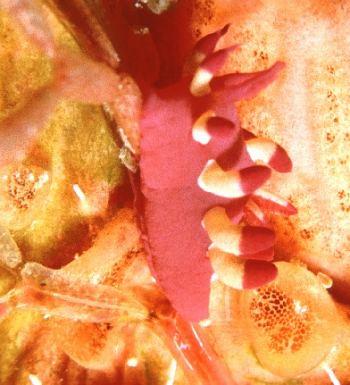
Dear Bill
Here are more photos of Hopkinsia from Kwajalein Atoll. Refer to earlier message for details.
Scott Johnson
johnson@kmr.ll.mit.edu
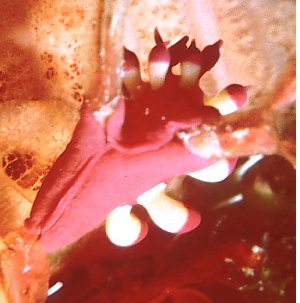
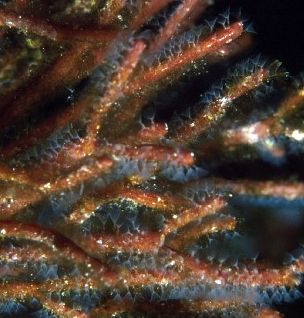
Thanks Scott,
As you mention earlier, these photos clearly show the foot being wrapped around the bryozoan stalk.
Bill Rudman
Hopkinsia - Kwajalein photos (2)
April 8, 2002
From: Scott Johnson
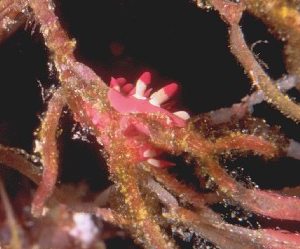
Dear Bill
Here are more photos of Hopkinsia from Kwajalein Atoll. Refer to earlier message for details.
Scott Johnson
johnson@kmr.ll.mit.edu
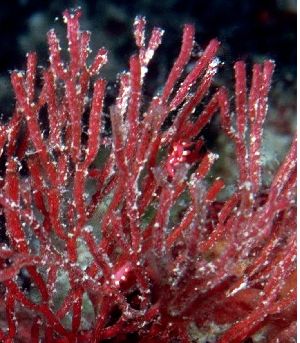
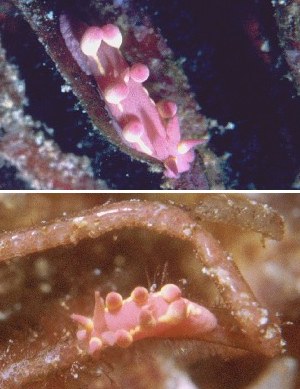
Thanks Scott,
I guess the centre and lower right photos are of a juvenile. On appendage count this would be Sakishimaia, but as you say it certainly looks like Hopkinsia nakamotoensis.
Bill Rudman
Hopkinsia nakamotoensis from the Marshalls
March 4, 2002
From: Scott Johnson
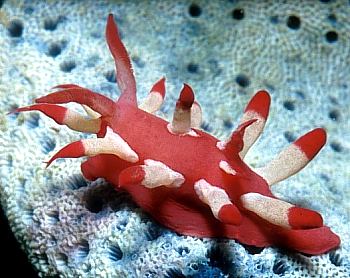
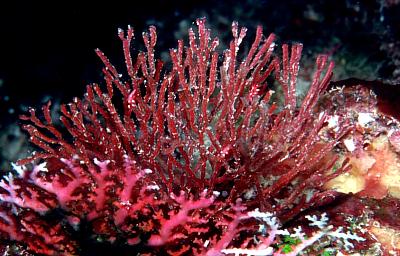
Hi Bill,
I think I can extend the range of Hopkinsia nakamotoensis. These shots were taken at Kwajalein, Marshall Islands. They are frequently found on the bryozoan in the lower photo, in ledges on certain lagoon pinnacles at depths of 10-20 meters, and range in size up to about 10mm.
Scott
johnson@kmr.ll.mit.edu
Johnson, S., 2002 (Mar 4) Hopkinsia nakamotoensis from the Marshalls. [Message in] Sea Slug Forum. Australian Museum, Sydney. Available from http://www.seaslugforum.net/find/6325Thanks Scott,
I have separated one of the photos that you sent with this message, the one from Enewetak Atoll, into a separate message as I think it is Sakishimaia kondoi. If nothing else, it may lead to further discussion.
Best wishes,
Bill Rudman
Re: Hopkinsia? or Okenia? sp.
February 19, 2002
From: Erwin Köhler
Dear Bill,
Concerning Atsushi Ono's message about Hopkinsia nakamotoensis and Sakishimaia kondoi. I don't want to judge if the appendages are bulbous or not, but S. kondoi should have 6 pairs of them and H. nakamotoensis 5 pairs. Georg's, Mike's and Dieter's (at my website) photos show specimens with 5 pairs of appendages. This would make them Hopkinsia nakamotoensis.
Cheers,
Erwin
Erwin@medslugs.de
Köhler, E., 2002 (Feb 19) Re: Hopkinsia? or Okenia? sp.. [Message in] Sea Slug Forum. Australian Museum, Sydney. Available from http://www.seaslugforum.net/find/6290Dear Erwin,
Thanks for drawing this to my attention.
I can count more than 5 - I just have to remember to use my other hand! If any one has a photo of Sakishimaia kondoi - with 6 pairs of appendages - I would be grateful.
Cheers,
Bill Rudman
Hopkinsia? or Okenia? sp.
February 16, 2002
From: Atsushi Ono
Dear Bill,
I think the two unidentified photos you have on the Forum as Hopkinsia? or Okenia? sp. have recently been named.
Bernard's photo is similar to Hopkinsia nakamotoensis Hamatani, 2001.
And Erwin's photo is similar to Sakishimaia kondoi Hamatani,2001.
• Hamatani, I. (2001) Two new species of Goniodorididae (Opisthobranchia; Nudibranchia) with a new genus from Kuroshima Island, Okinawa, Japan. Venus, 60(3): 151-156
Sincerely,
Atsushi Ono
ononini@cosmos.ne.jp
Ono, A., 2002 (Feb 16) Hopkinsia? or Okenia? sp.. [Message in] Sea Slug Forum. Australian Museum, Sydney. Available from http://www.seaslugforum.net/find/6212Dear Atsushi,
Thanks for drawing my attention to this paper. It recently arrived at the museum but I hadn't had a chance to read it. I have prepared pages for both species:
Hopkinsia nakamotoensis
Sakishimaia kondoi.
Best wishes,
Bill Rudman
Hopkinsia? or Okenia? sp.
March 26, 1998
From: Bernard Picton

Hi Bill,
Great idea - the web is supposed to be all about interaction and you've got it exactly right.
Thought you'd like a comment on the Hopkinsia/Okenia - this animal is illustrated as Okenia species 1 in Gosliner, Behrens and Williams' recent book on Indo Pacific Invertebrates. They describe it as feeding on a red bryozoan. Last September I was in SE Sulawesi with an expedition group called Operation Wallacea and my co-science officer Monica Sullivan started finding these animals and we collected a couple and their bryozoan - we were most disappointed on returning to see that Gosliner had beaten us to it as we had already nicknamed it Okenia monica! (jpeg attached)
Bernard Picton
bernard.picton.um@nics.gov.uk
Picton, B., 1998 (Mar 26) Hopkinsia? or Okenia? sp.. [Message in] Sea Slug Forum. Australian Museum, Sydney. Available from http://www.seaslugforum.net/find/69Hopkinsia? or Okenia? sp.
March 20, 1998
From: Erwin Koehler
Bill,
I've found Okenia sp. at
http://siolibrary.ucsd.edu/slugsite/phil/okeniasp.html.
It is the same as the one of my request.
Ciao
Erwin Koehler
Darmstadt, Germany
Medslugs.Koehler@t-online.de
Koehler, E., 1998 (Mar 20) Hopkinsia? or Okenia? sp.. [Message in] Sea Slug Forum. Australian Museum, Sydney. Available from http://www.seaslugforum.net/find/70Hopkinsia? or Okenia? sp.
March 16, 1998
From: Erwin Koehler

Hello,
a friend of mine gave some photos to me, to add them at my Mediterranean Slug Site. One of them looks rather similar to your Hopkinsia sp., done at the Philippines.
Maybe you can identify it? If you like you can copy and resize the jpg for your forum.
Photo by: Georg Heinze, Worfelden, Germany. Size: about 3 cm, Depth: about 20 m, Feb. 1997. Philippines
Erwin Koehler
Darmstadt, GERMANY.
Medslugs.Koehler@t-online.de
Koehler, E., 1998 (Mar 16) Hopkinsia? or Okenia? sp.. [Message in] Sea Slug Forum. Australian Museum, Sydney. Available from http://www.seaslugforum.net/find/71Your nudibranch is similar in shape to Hopkinsia, but there appears to be a distinct edge to the mantle all around the body. The cerata-like mantle papillae seem to be outgrowths of that edge which is much like the arrangement found in species of Okenia. Hopkinsia and Okenia are closley related and some authors have suggested they should be 'lumped' into one genus. Whatever transpires it appears to be an unnamed species, which is not unsurprising in the rich waters of the Philippines and Indonesian Archipelago. Let us hope the marine life survives the ecological disasters of reef dynamiting and land clearing which have destroyed a large percentage of the surviving marine ecosystems of the region.
Rudman, W.B., 1998 (Mar 16). Comment on Hopkinsia? or Okenia? sp. by Erwin Koehler. [Message in] Sea Slug Forum. Australian Museum, Sydney. Available from http://www.seaslugforum.net/find/71